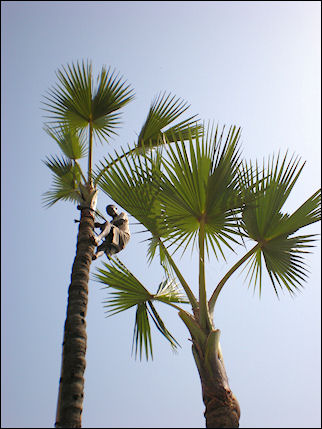
|
Burkina Faso
Ça va? Ça va la famille?
Ça va la santé?
Burkina Faso means "country of the honest people." The Burkinabé are not only honest, but also kind and cheerful, even though they live in one of the poorest countries in the world. Extensive greeting is an obligation. In the south-west of this Sahel country is Bobo-Dioulasso, the second city of Burkina Faso, with an extraordinary mosque and an animistic old city. Around Banfora one can bicycle along the Karfiguéla waterfalls, the Dômes of Fabédougou and villages with pottery makers and basket weavers. Not only waterlilies, but also hippoes float in Lake Tengrela.
Travelogue & photos: Ingrid Regout
Bamako - Bobo-Dioulasso
Touareg women disappear in the endless sand plains
From Bamako, the capital of Mali, I take the bus to Bobo-Dioulasso in the south-west of Burkina Faso. The bus usually takes a route via Sikasso, but because the rains have destroyed part of the road, we drive via Ségou and Koutiala.
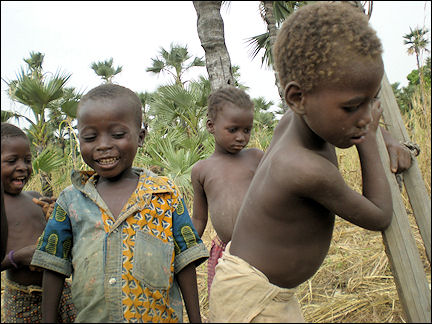
|
It is a 12-hours drive, but that doesn't mean that we are moving all the time. It starts in Bamako. The bus is only half-full, so I look forward to taking a nap on the bench. But before the bus leaves Bamako, it stops at a market and we are surprised by a large group of people, who enter the bus while talking and who take all left-over seats.
It's hot, very hot. But because November is winter for Burkinabese standards, the windows have to stay closed! To make things worse, I sit on the sunny side of the bus. The man next to me is kind enough to ask a lady for a pagne, a piece of fabric that women wear around their waists as skirts. He covers the window with it, so at least I sit in the shadow.
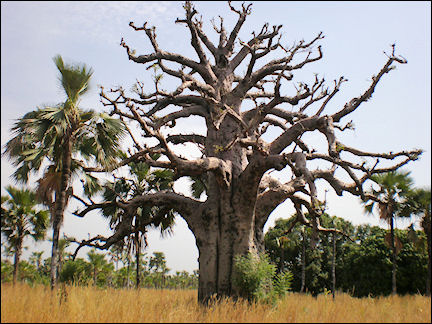
|
During the organized tour of Mali, which I just finished, I noticed that I was mainly looking forward to seeing Burkina Faso again. I was there in 1991, visiting a cousin who was working for a development agency in Dédougou.
We drove in landrovers through the Sahel, to villages where he would teach people to dig waterwells. The ritual upon our arrival was the same every time: first a visit to the village head, who would offer us dolo, a kind of beer, made of sorghum (millet). After this, we would offer him calebash dolo. Then everyone would gather under the mango tree: the village elders, the men, the women, the children. Even the turkeys watched from a wall.
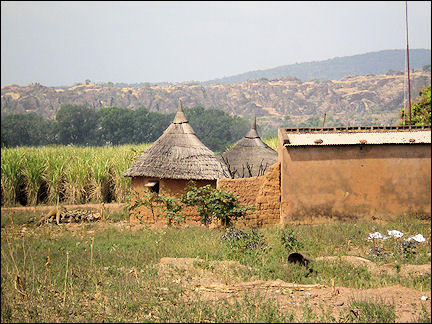
|
I also traveled by bus to Gorom-Gorom, known for its colorful camel and goat market where Touaregs and Peulh from all over the country come. A special experience, mainly because I just wandered around and watched, chatted with all kinds of people and drank a beer with a policeman.
Along the road, waiting for trucks to give me a ride back, I watched Tourareg women who came back from the market with blowing garments and disappeared in the endless sand plains. There also were hundreds of cows walking toward the town.
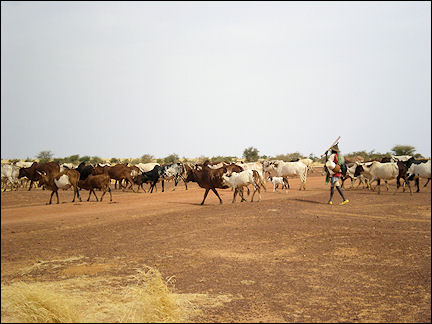
|
Every inhabitant of the Sahel region has one or two cows which graze the last remaining dry grass during the day and by the evening walk back to town "en file indienne"; each cow knows to which house it should walk.
On another occasion, while I was waiting for a taxi-brousse, someone hastily offered crude diamonds for sale.
And now I sit in the bus to Bobo-Dioulasso in the heat and finally return to Burkina Faso, where - by the way - it's very convenient to be able to speak French.
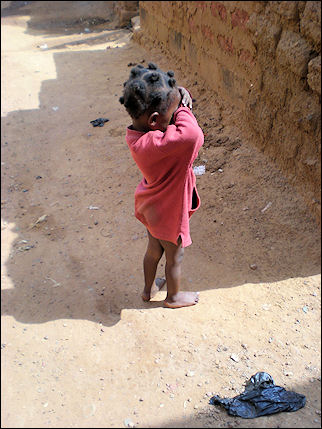
|
Every town in Mali and Burkina has a checkpoint on its entrance road, where cars and buses have to stop and show their papers. It doesn't mean a thing, it's more like an occasion to collect a bribe and to hear the latest news from the city where the car or bus is coming from.
After a number of checkpoints we arrive at the Mali border. Everyone has to get out and show their passports to the customs officer. We drive to the border of Burkina Faso. The same ritual: everyone gets off the bus and walks along the customs officers to have their passports checked.
At the next stop we have to take all our luggage from the bus and everyone has to take their own bagage along the customs. Then luggage and people are loaded on the bus again and we continue our drive.
Fortunately I brought some food and water. There are people who sell drinks and food everywhere, but it's not alway smart to take the risk.
Bobo-Dioulasso
The town center is an animistic village in the city
When we arrive in Bobo-Dioulasso (360.000 inhabitants) in the evening, I am approached immediately by a boy who offers me a taxi. This is not a problem in Burkina Faso, except that in this situation (foreigner arriving by bus in the dark) one pays too much, of course. But what is too much? 1000 francs CFA is only € 1.50.
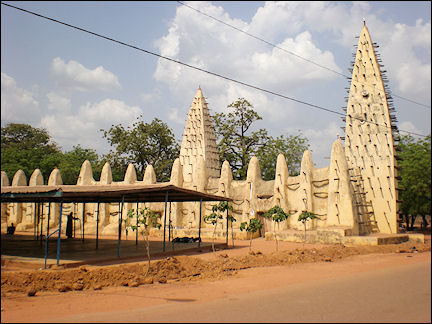
|
I am taken to Hotel Le Pacha, on the outskirts of Bobo. A fine hotel with a very kind staff. It also serves tasty, tender beef.
Next morning I take a cab which transports several passengers to the center of Bobo for only 100 CFA. Bobo is a pretty town with many tree-lined avenues. There is a huge market and a beautiful train station dating from 1933, where three times a week a train from and to Ouagadougou arrives.
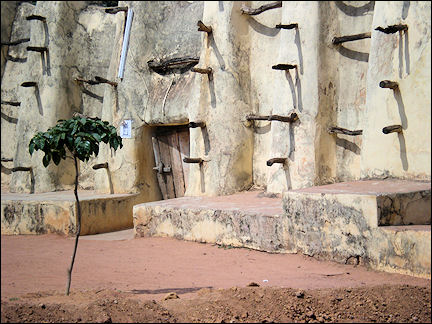
|
It's great to just wander and watch the activity in the streets. I visit an internet café to let the folks back home know that everything's okay.
Then a warm apple turnover with coffee in Pâtisserie Mouche. The culinary influence of France has even reached Burkino Faso. Two Burkinabé at another table are visited by their aunt, who carries big plastic bags. When she empties those on the table, masses of shoes and sandals appear. A walking shoe store, she succeeds in selling me a pair of beautiful sandals.
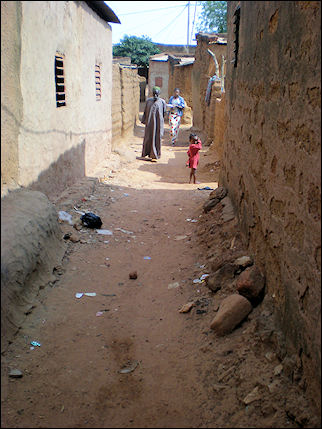
|
Then I visit the mosque of Bobo-Dioulasso, which is picture perfect. When I've hardly arrived, a guide already offers himself. It's best to take the offer, if you don't he - and others - will just keep pestering you.
It's also the easiest way to visit the mosque and the oldest, still animistic, part of town; the guide will tell you where you can and where you can't walk.
It's also easier to take pictures when you have a guide with you; and why shouldn't the guy earn some money?
The mosque has parallel galeries with sturdy supporting columns. There are prayer mats on the floor. Brooms to sweep the mats hang on the walls. We go up the roof and enter a minaret.
The guide takes me to the old city. Actually it's a village, a village in the city of Bobo, and animistic too. The part where the village head lives is considered sacred and cannot be entered by everyone. There are places where animal sacrifices take place (mostly chickens, a sheep now and then) and these spots are recognizable by the traces the rituals leave.
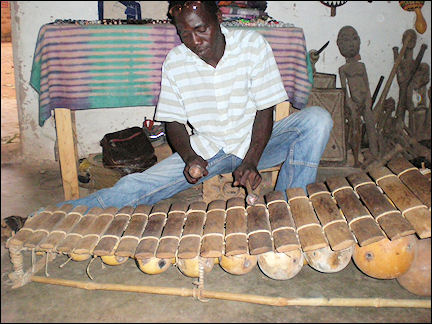
|
We visit the place where women make dolo (sorghum beer) and they let me taste a little. Behind me, an old woman keeps her eyes on my calebash, she wants to drink the rest of the dolo, which I give her.
Of course, the guide shows me his own store, which has necklaces and wooden sculptures. But the best thing: he demonstrates the balofon (a kind of xylophone made of calebash) and the djembé (drum). He tells me he plays in a band. Both Mali and Burkina Faso are famous for their talented musicians.
Banfora
A town with unpaved roads and all kinds of businesses
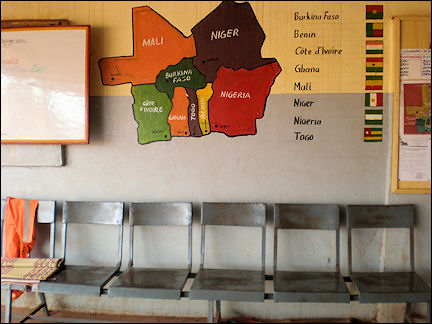
|
In the afternoon I take the bus to Banfora. At the bus station I meet a Swiss woman who is going to the same hotel in Banfora. We travel together and in Banfora take a taxi together to the hotel, which turns out to be at walking distance from the bus station.
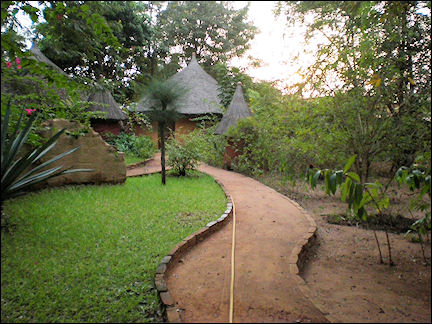
|
Hotel Canne à Sucre is a wonderful hotel. We can choose between a room and a paillote. I take a paillote, a round hut with all amenities: both air conditioning and a fan at the ceiling, toilet, shower and washbasin. A long, narrow, bent piece of wood on legs turns out to be a wonderful relax chair.
I don't get to see a lot of Banfora itself, except for the few streets we pass through by bicycle and the internet café. It's a town (60.000 inhabitants) with unpaved roads, along which are all businesses: a place to charge batteries, public phone, internet café, bicycle and moped repair, barber, forge, you name it. All trades are represented.
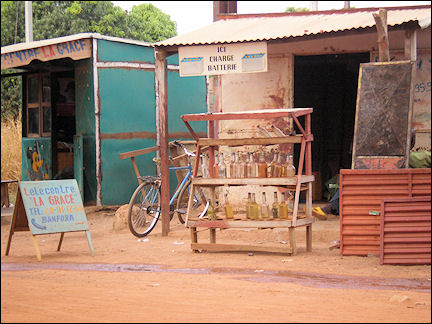
|
The Swiss woman and I rent bikes and hire a guide. This turns out to be perfect. The three of us bicycle for two days in the surroundings of Banfora. A wonderful way to see a lot that one would just pass by in a car.
An adventurous bicycle trip
Karfiguéla waterfalls and the Dômes of Fabédougou
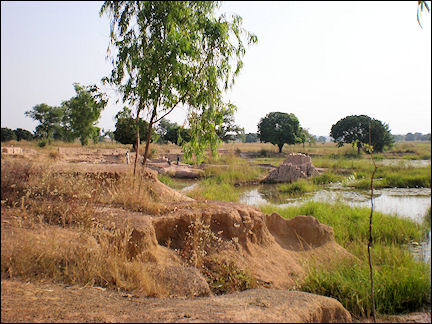
|
On the first day we bicycle to the waterfalls of Karfiguéla and the Dômes of Fabédougou. Well, waterfalls... there's so many of them. But still, every time they're pretty. These are also special, because they have different levels.
We arrive after an adventurous bicycle trip: Soon - fortunately just when we enter a village - my biking companion has a puncture. No sweat. In Burkina, nothing is thrown out, everything is repaired over and over again, so I am not surprised that this village has a bike repair shop.
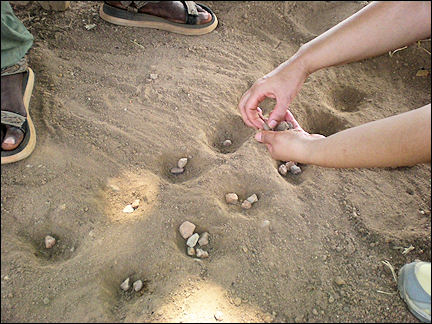
|
While we wait, our guide amuses us by explaining the game awalé. Twelve holes and 12x4 stones. It can be played everywhere were there is sand - and that is almost everywhere in Burkina.
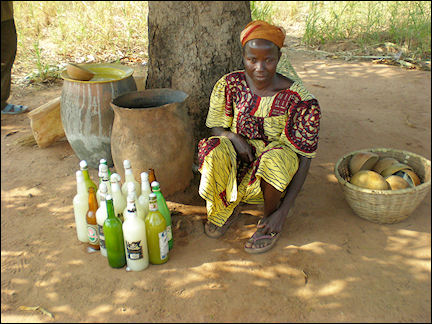
|
This way, time flies while we wait for the bicycle to be repaired. In a good mood we continue our bike ride, resting once in a while - or rather: recovering from the heat - under a mango tree, where there sometimes is a cabaret. That is a spot where a woman sells bottles of banji (palm wine).
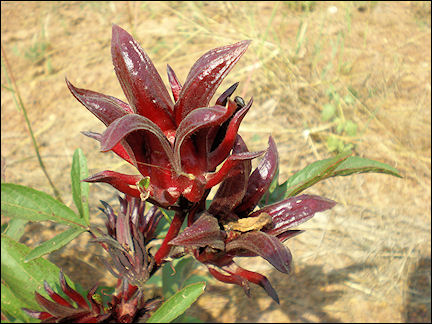
|
On the way our guide shows us pods with seeds of recently harvested sesame plants, which are drying in sheaves. We pass large termite mounds and see the flower of which bissap is made, a tasty, fresh, non-alcoholic drink.
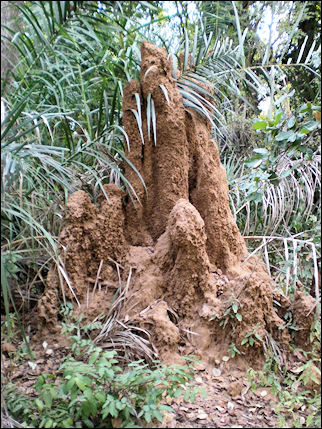
|
We bicycle amidst sugercane fields. These fields are huge and round. Round, because this way the watering cart can make its rounds staying at the center. Paths are left open for its wheels.
When we arrive in the area of the Karfiguéla waterfalls and the Dômes of Fabédougou, we park our bicycles at the entrance and buy tickets. We walk to the waterfalls, ascending slowly between two wide steel tubes.
They are pipes that transport water to Banfora. When we look incredulous, the guide tells us to touch the pipes. And yes, they are wonderfully cool, despite the fact that they lie in the scorching sun.
The guide points out a sacred pool, somewhere in the greenery, where a marabout sits, who helps people with their problems, he's a kind of priest. They must sacrifice a chicken or a sheep every time they come for help. Afterwards, it is eaten on the spot, with family and friends. We are not allowed to enter the sacred space, but even where we walk, the ground is covered with chicken feathers.
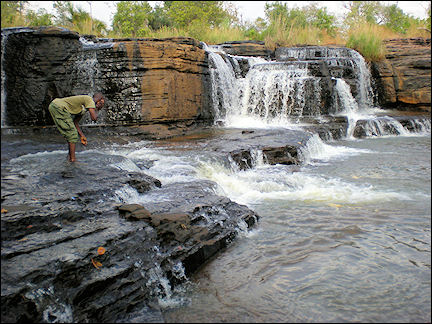
|
Eventually we arrive at the highest point of the waterfalls. The surroundings are beautiful. We cross the water to have a picnic and siesta on the rocks in the shadow. It's the hottest hour of the day. Red dragonflies fly around, people come to take a bath in the water. We don't, we are afraid to catch bilharzia.
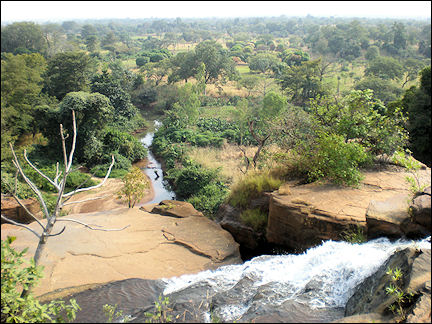
|
After our siesta we walk back down, for a while along the waterfall and then take the same we back to visit the de Dômes of Fabiédougou. These are incredibly beautiful, impressive rock formations, eroded in the shape of domes. We climb them and have a great view of the sugarcane fields on the other side.
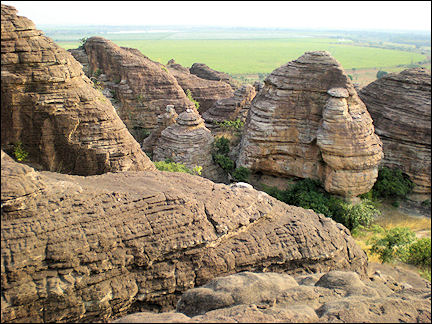
|
On the way back to Banfora we take a different route and see several beautiful birds in the sugercane fields, in the quiet and the wonderful evening light.
Every part of the palm tree is used
Visiting potters' and basket weavers' villages
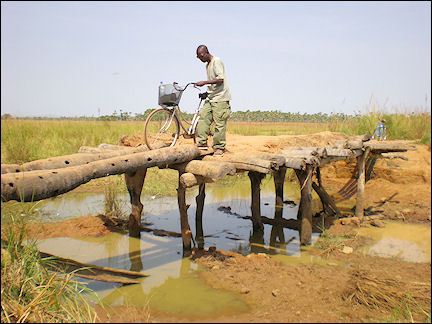
|
On the second day we bicycle to the village of the potters and the village of the basket weavers. Both trades are only done by women.
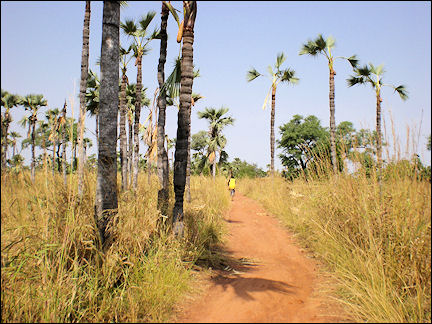
|
On the way the guide explains how every part of the rônier, or palmyra palm tree, is used. The trunk is as hard as concrete and can therefore be used in construction; it is used to build bridges.
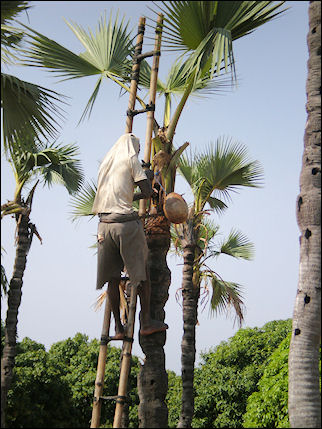
|
The coconuts are only used for their juice, the meat is worthless. The leaves are used for weaving mats and baskets, chairs are made of the stems of the leaves; and from the juice of the tree itself, palm wine is made.
Two to three times a day a man climbs the palm trees to re-open the wound from which the juice flows, collects it in a mug and sells it.
When we arrive in the potters' village, we see women working, sitting on the ground in the shadow of some trees. One kneads a big lump of clay, another shapes - without a potters's wheel - large pots and a third shapes the rims.
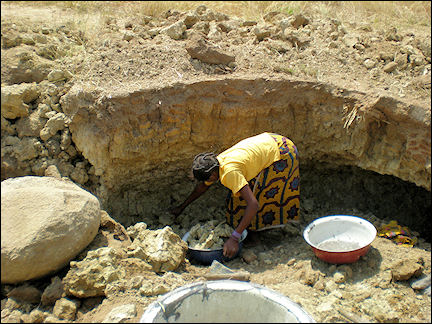
|
Outside the village we see how women hack clay from a lower layer of soil and transport it in containers to a place where it is layed out to dry.
Then it's time for our picnic and siesta. We attract a large crowd of women and children. When we practice our greeting ritual on an old woman Ça va? Ça va la famille? Ça va la santé?, she answers with Ça va and then repeats our Ça va la famille. Apparently, she doesn't speak French and just repeats what we're saying.
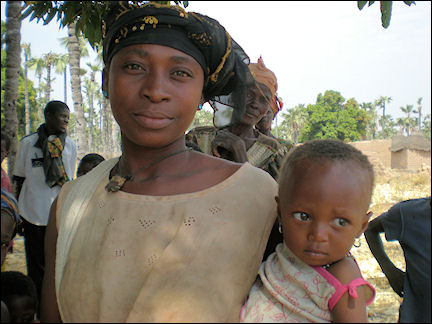
|
We have to take a small child in our arms. We take pictures, which we immediately show on the little screen of our digital camera. They think it's hilarious.
When the guide eventually succeeds in sending everyone off, so we can rest, chickens with loudly squeaking chicks arrive...
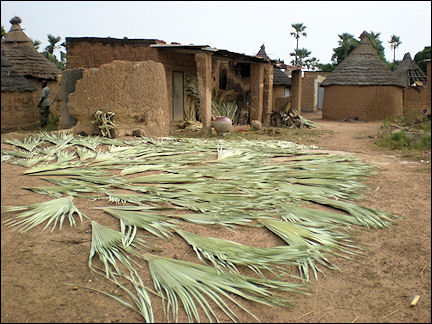
|
As soon as the worst heat is over, we bicycle to the basket weavers' village. Also this craft is only done by women. The fan-like leaves of the palmyra are picked and dried. After this, they are so dry that they break easily.
Outside the village large holes in the ground are dug. In these holes the leaves become supple. Women sit in the holes, weaving mats and baskets.
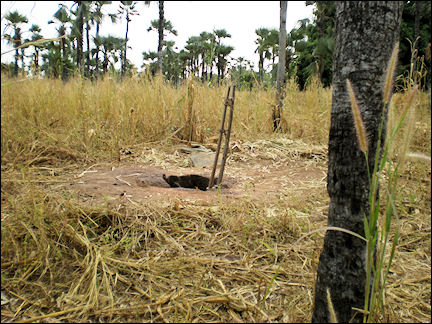
|
On the way back to Banfora, we are surprised by a rain shower. Pas de problème (a much uttered slogan here), we can take shelter under the dense crown of a mango tree. Moreover, it's not cold at all, so even if we'd get wet, we wouldn't catch a cold.
Lake Tengrela
In the daytime the hippoes lie in the water
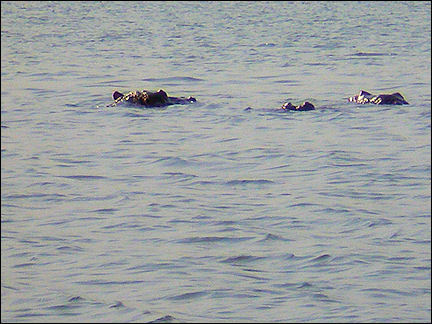
|
About 15 km outside Banfora is Lake Tengrela, known for its hippoes. Who would have thought: in West Africa and still a little bit of safari. There seem to be 26 hippoes in the lake. At night they climb out, but in the daytime they just float in the water. One can rent a canoe with a boatswain, who will take one to them.
It's exciting to peer at the water surface and then all of a sudden yell: "There! There is one over there!"
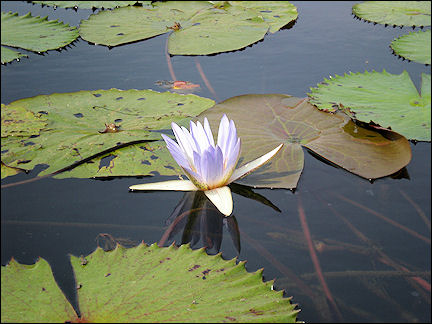
|
Many white and blue waterlilies are blossoming in the lake. The boatswain makes beautiful necklaces from flowers with stalks and hangs it around our necks, as if we were in Hawaii.
Sadly, this is the end of my visit in Banfora, because I have to return to Bamako in Mali for my flight back. Just like in 1991, the most impressive experience was the exceptional kindness and cheerfulness of the population. There are many children, actually too many, but they are so sweet.
Next day I leave in the morning by bus to Bobo Dioulasso, where I walk that afternoon to the old city to buy a wood-cut awalé game. Near the mosque I hear a cheerful Bonjour! Ça va? And yes, it is the guide who gave me a tour four days ago. That is a lucky coincidence, because he can surely help me find an awalé game. Pas de problème!
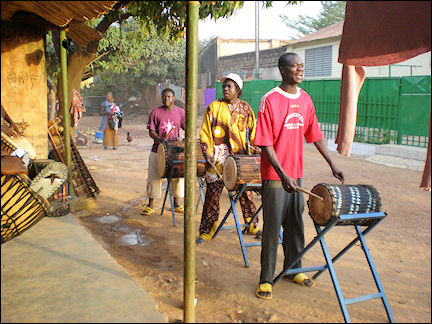
|
He takes me to his store, sits me down on a wooden stool and disappears to find a man from his village who undoubtedly has one of those games for sale. We negotiate about the price and eventually everyone is happy.
When we leave, we see a group of musicians practice in the street. That same night they perform in a dance hall in Bobo. They are great! A wonderful, musical end of my stay in Burkina Faso. Next day I spend 12 hours in the bus back to Bamako, this time it has air conditioning. Burkina, je reviendrai!